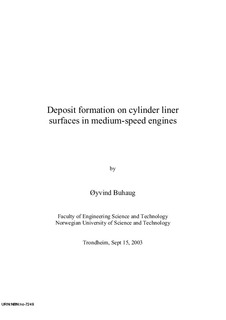| dc.contributor.author | Buhaug, Øyvind | nb_NO |
| dc.date.accessioned | 2014-12-19T11:24:38Z | |
| dc.date.available | 2014-12-19T11:24:38Z | |
| dc.date.created | 2003-11-12 | nb_NO |
| dc.date.issued | 2003 | nb_NO |
| dc.identifier | 124049 | nb_NO |
| dc.identifier.isbn | 82-471-5641-5 | nb_NO |
| dc.identifier.uri | http://hdl.handle.net/11250/231180 | |
| dc.description.abstract | The presence of deposits in the honing grooves in diesel engine cylinder liners can cause a severe increase in the consumption of lubricating oil. These deposits may appear amber in which case they may be referred to as 'liner lacquerer' or be nearly invisible in which case they are often referred to as 'transparent glaze' or 'bore glaze' in the marine sector. The formation of these deposits is believed to be influenced by engine design, engine load, fuel composition and lubricating oil composition. This relationship has, however, not been well understood and little material has been published on this subject. This thesis describes an investigation of this phenomenon. The problem has been approached by studying the composition of deposit samples, studying cases of deposit formation in the field and through experimental work.
As a result of this work, it is hypothesized that the root cause of the deposit formation is a mismatch between the rate of formation of oil insoluble material on or within the oil film and the oil film dispersing power and exchange rate. A large number of parameters will affect this balance which explains the sliding shift in appearance and composition of 'liner lacquer' and 'bore glaze' and the difficulty in identifying the cause of this problem.
A combined mass balance and chemical kinetics approach is used to bridge the gap between fundamental deposit theory and tangible engine related parameters. It is thus possible to rationalize the formation of deposits on cylinder liners. This understanding is sufficient to point out which factors should be considered in terms of the prevention of deposit formation and to present a viable hypothesis on the reason for the deposit formation in the engines that have been investigated in the course of this work as summarized in the following paragraph.
The presence of deposit indicates that the dispersing power and transport rate of the oil film is insufficient to deal with the deposit precursors being formed. This is believed related to extensive low load operation which is associated with both low liner temperatures and low nominal oil consumption in these engines. Low liner temperatures will encourage the formation of insoluble material due to condensation of sulphuric acid precursors, while low oil consumption is believed to indicate low oil film exchange which reduces the transport of matter and also contributes to oil film oxidation by prolonging the exposure to combustion gases. | nb_NO |
| dc.language | eng | nb_NO |
| dc.publisher | Fakultet for ingeniørvitenskap og teknologi | nb_NO |
| dc.relation.ispartofseries | Dr. ingeniøravhandling, 0809-103X; 2003:87 | nb_NO |
| dc.title | Deposit Formation on Cylinder Liner Surface in medium-speed Engines | nb_NO |
| dc.type | Doctoral thesis | nb_NO |
| dc.source.pagenumber | 289 | nb_NO |
| dc.contributor.department | Norges teknisk-naturvitenskapelige universitet, Fakultet for ingeniørvitenskap og teknologi | nb_NO |
| dc.description.degree | dr.ing. | nb_NO |
| dc.description.degree | dr.ing. | en_GB |
